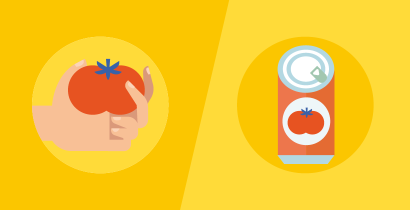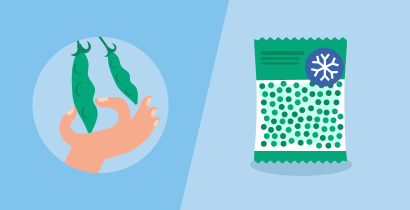Food processing: understanding its methods, examples and importance
Last Updated : 31 July 2024Walk into any supermarket and you can find a wide range of varied processed foods: from frozen fish filets in the freezer section, canned chickpeas over in the middle aisles, to freshly baked breads and pastries at the bakery counter. But what does the term food processing actually mean? And why do we process our food? This article explains food processing, different examples of food processing methods, and the positive and negative implications of food processing.
What is food processing ?
While definitions can vary, one common definition of food processing is any action or procedure that changes the initial food or raw materials used to produce food (such as crops, water and so on).1 This can involve one or a combination of processes such as washing, chopping, pasteurising, freezing, fermenting, packaging, heating, milling, extruding, or adding ingredients to foods, for example to extend storage life. Processing can also refer to the transformation of ingredients into food products, for example making bread. Food processing can take place both at home, out-of-home (for example in restaurants and cafeterias), and at an industrial scale. By this definition, it becomes clear that the majority foods we eat in our day-to-day lives are processed to some extent.

What are examples of food processing methods?
Food processing includes traditional (heat treatment, fermentation, pickling, smoking, drying, curing) and modern methods (pasteurisation, ultra-heat treatment, high pressure processing, or modified atmosphere packaging). Some of the common methods are described below:2
Heating
Cooking impacts the amount of nutrients in our foods. While in some cases it can help make some nutrients more available for absorption (e.g., beta-carotene in carrots or lycopene in tomatoes), it can also lead to some nutrients being lost. Particularly vitamin C is sensitive to heat and cooking. For example, when we boil vitamin C rich foods such as broccoli or kale, some of this vitamin is lost in the cooking water. To retain the most nutrients, the best cooking methods are those that use minimal water and heat and are relatively quick. Steaming, for example, is a great way to cook vegetables and retain their nutrients as it doesn’t involve submerging them in water. Microwaving also retains most nutrients as foods are heated relatively quick.
Baking, frying, or roasting starchy foods (e.g., bread, potatoes, biscuits, coffee) at high temperature can also lead to the formation of acrylamide. Prolonged exposure to high levels of acrylamide has been shown to cause cancer in animals. However, the evidence in humans is not as clear. Although humans are usually exposed to doses lower than those used in animal research, the general advice is to keep exposure low by taking care to avoid over-browning when cooking starchy foods, limiting acrylamide formation.
Canning
Canning allows us to preserve excess harvest. The food is heated to a high temperature. This process is called pasteurisation. Then, the food is packaged and stored in an air-tight can. Check our infographic showing the processing steps for canned tomatoes.
Canned fruits and vegetables are typically less expensive than both fresh and frozen produce.3However, canned vegetables can contain high levels of sodium and canned fruits can contain added sugar (syrup). Look for canned vegetables with ‘no added salt’ and fruit canned ‘in juice.’ Don’t buy cans or packages that are torn, damaged or disfigured in some way. Foods in dented cans or punctured wraps should not be eaten as it might have become contaminated with harmful microorganisms.
Drying/dehydration
Drying removes the water content of food. In the case of dried fruit, this means that the fruit sugar and calories end up concentrated in a smaller package. However, it contains the ‘whole fruit,’ and therefore a package of nutrients and bioactives. A 30-gram portion of dried fruit (max. once a day) contributes to one of your 5-a-day.
Juicing
Juices are squeezed from the fruit or vegetable; their pulp is often removed so in the end they contain less fibre. Because juices are liquid, we tend to consume a high quantity quickly, which does not make us feel as full compared to eating whole fruit. Juice labelled ‘from concentrate’ goes through an extra process where the fresh juice is dehydrated, packaged for transport and then mixed with water.
Choose 100% fruit juice (with pulp), and limit to max. 150 ml in one day.
Fermentation
Fermentation is the breakdown of sugars by bacteria, yeasts or other microorganisms under anaerobic conditions. This means, no oxygen is needed for the process to take place (apart from oxygen present in sugar). Fermentation is used in the production of alcoholic beverages such as wine, beer, and cider, and in the preservation of foods such as sauerkraut, dry sausages, and yoghurt, but also for raising dough in bread production.
Freezing
Freezing reduces food temperatures to below 0 oC to slow the loss of nutrients and prevent food spoilage, particularly when frozen soon after harvest. The process can be used to preserve the majority of foods including fruits, vegetables, meat, fish, and ready meals. Do you know the steps needed to produce frozen peas? Check them out here!
Frozen vegetables provide a convenient way to help reach 5-a-day. Pre-prepared foods with a long shelf life can also be useful for people with limited time or food preparation skills.
Modified atmosphere packaging
During modified atmosphere packaging, air inside a package is substituted by a protective gas mix, often including oxygen, carbon dioxide and nitrogen – gases that are also present in the air we breathe. They help to extend the shelf life of fresh food products - usually of fruits, vegetables, meat and meat products, and seafood.
Pasteurisation
Pasteurisation involves heating foods and then quickly cooling them down to kill microorganisms. For example, raw milk may contain harmful bacteria that cause foodborne illnesses. Boiling it (at home) or pasteurising (on a large scale) is crucial to ensure it is safe to consume. Apart from dairy products, pasteurisation is widely used in preservation of canned foods, juices and alcoholic beverages.
Smoking
Smoking is a process of heat and chemical treatment of food to help preserve it by exposing it to smoke from burning material such as wood. Smoked foods usually include types of meat, sausages, fish or cheese.
Additives
Food additives play an important role in preserving the freshness, safety, taste, appearance and texture of processed foods. Food additives are added for particular purposes, whether to ensure food safety, or to maintain food quality during the shelf-life of a product. For example, antioxidants prevent fats and oils from becoming rancid, while preservatives prevent or reduce the growth of microbes (e.g. mould on bread). Emulsifiers are used for instance in improving the texture of mayonnaise, or stopping salad dressings from separating into oil and water. All food additives undergo a rigorous scientific safety evaluation before they can be approved for use. The safety of food additives is regularly evaluated by the European Food Safety Authority to ensure that any newly generated scientific evidence is taken into account, and if needed, measures are taken to protect consumers.
Pulsed electric fields technology
Pulsed electric fields (PEF) technology is an innovative mild food preservation technique that involves the use of short electricity pulses to destroy harmful bacteria in liquid products (e.g., juice, milk, smoothies, purees) and extends their shelf life while minimally affecting their fresh character. PEF technology is used and tested for different goals, such as to preserve juice or as pre-treatment before drying to enhance releasing water from fruit.
Compared to classical heat pasteurisation, benefits of PEF technology include a higher food quality and nutritional value, extended shelf life, preservation of the natural way of the product without the need to add preservatives, and a lower energy use.

Why is food processing important ?
Food processing methods can sometimes be considered essential, for example, for making food edible and safe to eat, making seasonal produce available all year, improving shelf-life and reducing food waste, preventing deficiencies through fortification, and producing products for special dietary or sustainability needs (e.g., gluten-free or plant-based alternatives).1 Food processing can also cause some fibre and vitamins and minerals to be lost, for example, through excessive refining or heating. Research on the impact of different types and combinations of food processing on both foods and our health is still under investigation.
With so many ways available to process food, and combine ingredients, the resulting products can be very different. Products can contain different ingredients, such as fruits or vegetables, or wholegrains, and added ingredients such as fat, sugar, or salt. Compare the food labels and check your national food guidelines for more information or suggestions on how to include these products in a healthy and sustainable diet. Some products contain high levels of saturated fat, added sugar or salt, are calorie dense, and may contain less fibre, and are therefore best consumed only occasionally. When cooking at home, be mindful to limit added sugar, salt, and saturated fats.

Summary
Food processing is an integral part of our daily lives, transforming raw ingredients into the diverse array of foods we eat. From traditional methods like canning and freezing to modern innovations such as pulsed electric fields technology, each process plays a role in making food edible, safe, accessible, and convenient. However, food processing can also cause nutrient losses (e.g., fibre, vitamin C) or includes the addition of excess saturated fat, added sugar or salt, making the final product more calorie dense and better part of an occasional treat. Ongoing research continues to unravel the intricate connections between processed foods and health. As consumers, understanding food labels and adhering to national dietary guidelines can help us make informed choices for a healthy and sustainable diet.
References
- Sadler C et al. (2021) Processed food classification: Conceptualisation and challenges. Trends in Food Science and Technology 112:149.
- Floros, J. D., Newsome, R., Fisher, W., Barbosa‐Cánovas, G. V., Chen, H., Dunne, C. P., ... & Ziegler, G. R. (2010). Feeding the world today and tomorrow: the importance of food science and technology: an IFT scientific review. Comprehensive Reviews in
- Miller, S. R., & Knudson, W. A. (2014). Nutrition and cost comparisons of select canned, frozen, and fresh fruits and vegetables. American Journal of Lifestyle Medicine, 8(6), 430-437.



